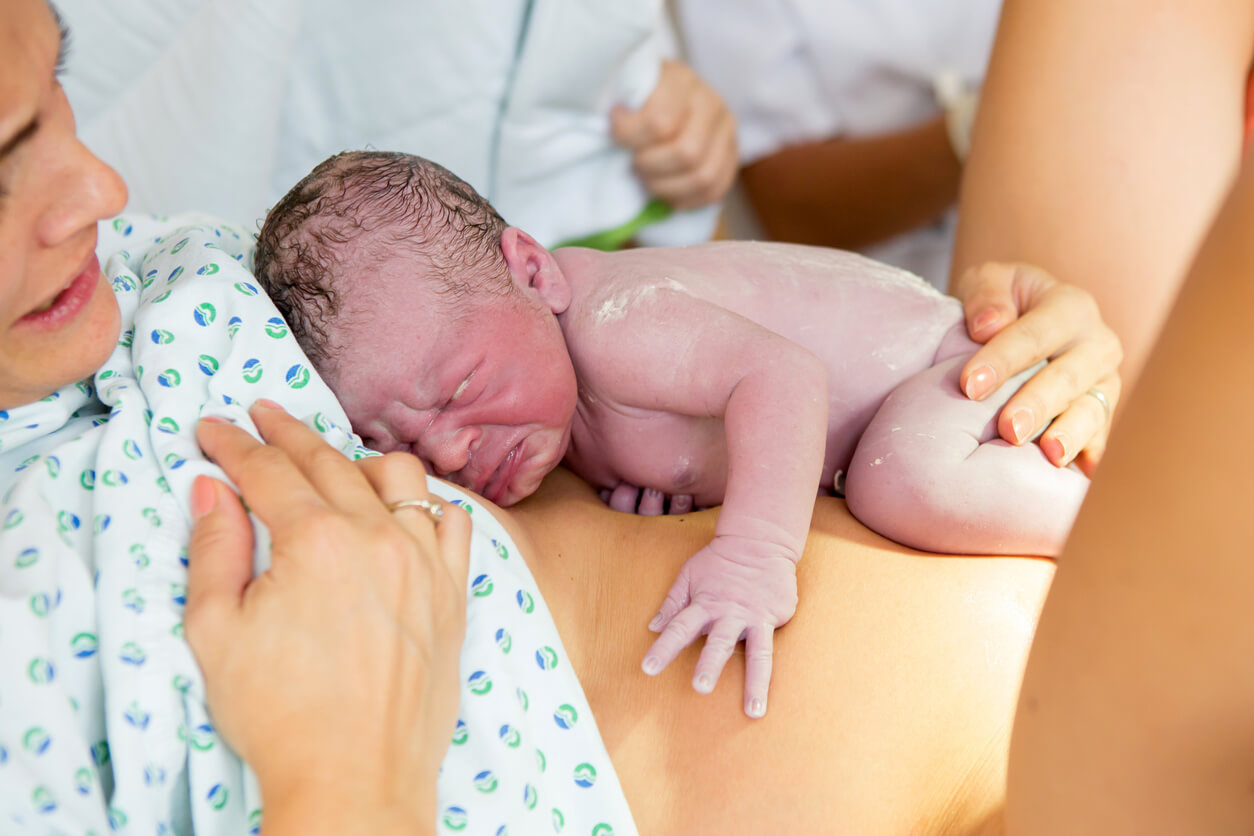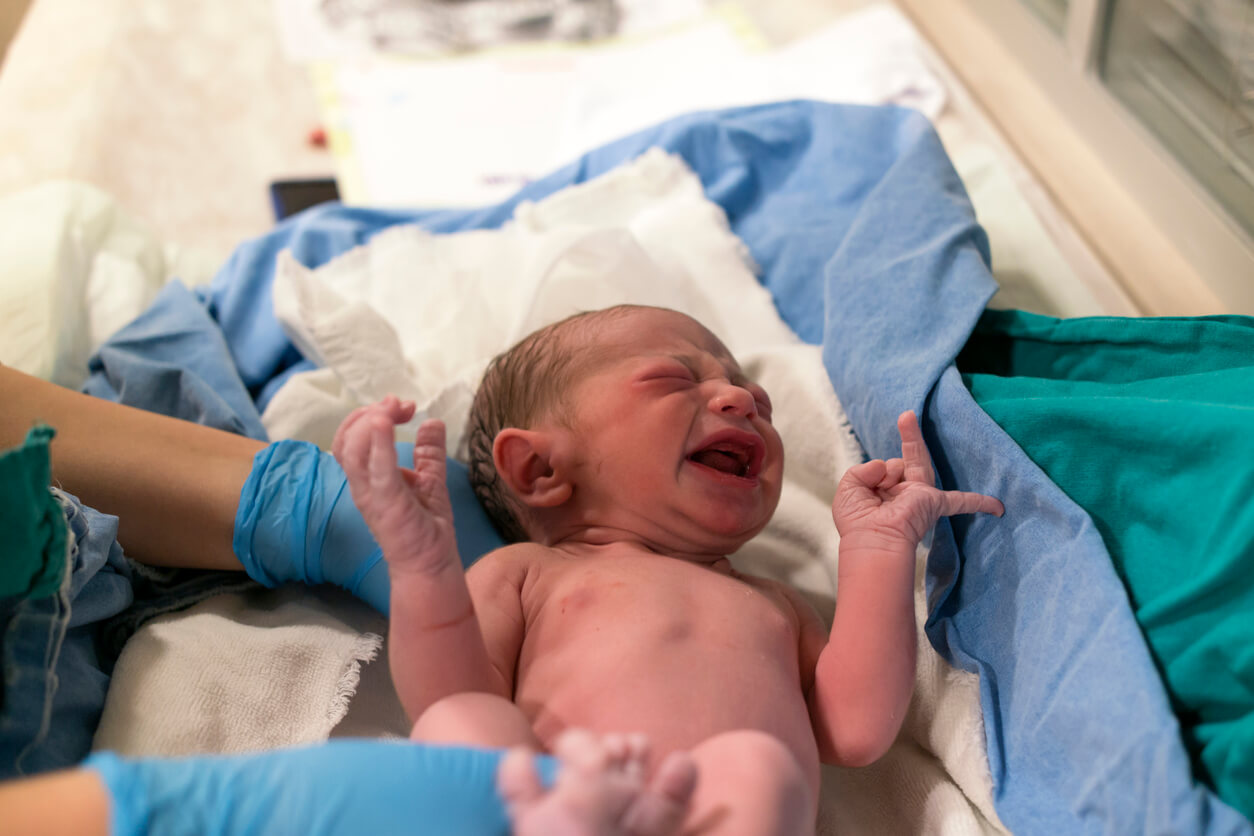Are Newborn Babies Ugly?


Written and verified by the dermatologist Maria del Carmen Hernandez
During the 9 months of gestation, parents anxiously prepare to welcome their new family member. But immediately after delivery, many are taken aback because their newborn babies don’t look exactly as they expected. This leads them to ask themselves the following question: Are newborn babies ugly?
Of course not! But they do have some characteristic features from the birth process that give them that appearance. The good thing is that these are usually temporary changes and, after a few days, they’ll take on that precious baby look you were expecting. Find out more in this article.
Why are some newborn babies ugly at birth?
Newborn babies don’t have the same appearance they’ll have months later. Many parents imagine their children with chubby, pink, round cheeks at birth. But the truth is that they come into this world purple, wrinkled, with slightly elongated heads and pale, cold hands.
These features reflect the conditions of life inside the womb (where, for example, the level of oxygen in the blood was lower) and adaptations to childbirth. Regarding the latter, one of the clearest examples is cranial modeling during vaginal delivery, which is the crushing of the head in order to pass through the mother’s vagina.
Fortunately, the human body adapts quickly to the new living conditions and these changes in physiognomy tend to resolve themselves within a few days or weeks.

Read also: Anatomical and Physiological Changes During Labor
Skin coloration of newborn babies
The skin coloration of a newborn baby can vary depending on ethnicity or race, temperature, age, and attitude (for example, crying or calm).
At birth, the baby’s skin is purple or dark red, but with the onset of breathing outside the womb, it becomes pinker. However, the color of the feet and hands may remain bluish for a longer time. This is because the vessels that carry blood to these parts of the body are the last to develop.
In fact, all these changes in color are related to the lack of development of blood circulation in newborns, which is normal and to be expected.
On the other hand, when the coloration of the skin or mucous membranes is yellow (known as jaundice), this may indicate some kind of condition.
What is vernix caseosa?
Vernix caseosa is one of the reasons why newborn babies are given an ugly appearance. It’s a greasy, whitish film that covers the entire body surface of the newborn. It’s composed of desquamated skin and sebum from the sebaceous glands and is produced in the last stage of pregnancy.
The main function of the vernix is to protect the delicate skin of the newborn and to facilitate adaptation to the extrauterine environment. According to data from a review in The Journal of Obstetrics and Gynaecology Research, other important functions include the following:
- It favors temperature regulation.
- It provides protection against water loss through the skin.
- It participates in innate immunity strategies.
- It’s involved in intestinal development.
You may be interested in: 6 Tips for Your Newborn Baby’s First Bath
What is lanugo?
Neonates have soft, thin, unpigmented hair that covers the surface of their bodies. This hair is called lanugo and contributes to the bond between the vernix caseosa and the skin of infants.
During the first few weeks of life, lanugo is replaced by terminal hair. In fact, some studies suggest that the most beautiful appearance of babies is obtained from 3 to 6 months of age, when they’ve replaced their skin and hair.
Characteristics of the head of newborns
Babies develop inside the uterus and live submerged in amniotic fluid. In addition, they remain with their bodies flexed in a very narrow space (in the fetal position) and pass through a very narrow canal to emerge into the world.
Consequently, the skull, which is made up of multiple bones, is born disarticulated (i.e., separated). The spaces and holes that delimit each bone are called sutures and fontanelles, respectively.
Both the sutures and the anterior and posterior fontanelles are kept open, soft, and flat to pass through the birth canal. Therefore, at birth, the head presents an irregular and conical shape, which can give babies a more “ugly” appearance.
In general, by the end of the first week, the head returns to its normal shape. And after a few weeks or months, the bones of the skull fuse together and the spaces close completely.
The appearance of the face of newborns
The face of a newborn often looks very swollen, as a result of fluid accumulation and the complicated passage through the birth canal.
In general, these babies have a flattened face and swollen eyelids. But that situation resolves spontaneously when the excess fluid is removed and the traumatic birthmarks are relieved.
Other facial features that may develop from compression in the birth canal include the following:
- Twisted jaw
- Flattened nose
- Bent ears, as the ear cartilage that provides firmness to this structure hasn’t yet developed
The eyes may even appear crossed or out of place, as they don’t focus well during the first few days. However, this corrects itself after 2 or 3 months.

Newborn babies have temporary features
In conclusion, newborn babies will noticeably change in appearance from the first day of life. Therefore, the initial features shouldn’t worry you as they’re temporary. You’ll see that after a month, they’ll already look angelic, with smooth and even skin. Congratulations!
During the 9 months of gestation, parents anxiously prepare to welcome their new family member. But immediately after delivery, many are taken aback because their newborn babies don’t look exactly as they expected. This leads them to ask themselves the following question: Are newborn babies ugly?
Of course not! But they do have some characteristic features from the birth process that give them that appearance. The good thing is that these are usually temporary changes and, after a few days, they’ll take on that precious baby look you were expecting. Find out more in this article.
Why are some newborn babies ugly at birth?
Newborn babies don’t have the same appearance they’ll have months later. Many parents imagine their children with chubby, pink, round cheeks at birth. But the truth is that they come into this world purple, wrinkled, with slightly elongated heads and pale, cold hands.
These features reflect the conditions of life inside the womb (where, for example, the level of oxygen in the blood was lower) and adaptations to childbirth. Regarding the latter, one of the clearest examples is cranial modeling during vaginal delivery, which is the crushing of the head in order to pass through the mother’s vagina.
Fortunately, the human body adapts quickly to the new living conditions and these changes in physiognomy tend to resolve themselves within a few days or weeks.

Read also: Anatomical and Physiological Changes During Labor
Skin coloration of newborn babies
The skin coloration of a newborn baby can vary depending on ethnicity or race, temperature, age, and attitude (for example, crying or calm).
At birth, the baby’s skin is purple or dark red, but with the onset of breathing outside the womb, it becomes pinker. However, the color of the feet and hands may remain bluish for a longer time. This is because the vessels that carry blood to these parts of the body are the last to develop.
In fact, all these changes in color are related to the lack of development of blood circulation in newborns, which is normal and to be expected.
On the other hand, when the coloration of the skin or mucous membranes is yellow (known as jaundice), this may indicate some kind of condition.
What is vernix caseosa?
Vernix caseosa is one of the reasons why newborn babies are given an ugly appearance. It’s a greasy, whitish film that covers the entire body surface of the newborn. It’s composed of desquamated skin and sebum from the sebaceous glands and is produced in the last stage of pregnancy.
The main function of the vernix is to protect the delicate skin of the newborn and to facilitate adaptation to the extrauterine environment. According to data from a review in The Journal of Obstetrics and Gynaecology Research, other important functions include the following:
- It favors temperature regulation.
- It provides protection against water loss through the skin.
- It participates in innate immunity strategies.
- It’s involved in intestinal development.
You may be interested in: 6 Tips for Your Newborn Baby’s First Bath
What is lanugo?
Neonates have soft, thin, unpigmented hair that covers the surface of their bodies. This hair is called lanugo and contributes to the bond between the vernix caseosa and the skin of infants.
During the first few weeks of life, lanugo is replaced by terminal hair. In fact, some studies suggest that the most beautiful appearance of babies is obtained from 3 to 6 months of age, when they’ve replaced their skin and hair.
Characteristics of the head of newborns
Babies develop inside the uterus and live submerged in amniotic fluid. In addition, they remain with their bodies flexed in a very narrow space (in the fetal position) and pass through a very narrow canal to emerge into the world.
Consequently, the skull, which is made up of multiple bones, is born disarticulated (i.e., separated). The spaces and holes that delimit each bone are called sutures and fontanelles, respectively.
Both the sutures and the anterior and posterior fontanelles are kept open, soft, and flat to pass through the birth canal. Therefore, at birth, the head presents an irregular and conical shape, which can give babies a more “ugly” appearance.
In general, by the end of the first week, the head returns to its normal shape. And after a few weeks or months, the bones of the skull fuse together and the spaces close completely.
The appearance of the face of newborns
The face of a newborn often looks very swollen, as a result of fluid accumulation and the complicated passage through the birth canal.
In general, these babies have a flattened face and swollen eyelids. But that situation resolves spontaneously when the excess fluid is removed and the traumatic birthmarks are relieved.
Other facial features that may develop from compression in the birth canal include the following:
- Twisted jaw
- Flattened nose
- Bent ears, as the ear cartilage that provides firmness to this structure hasn’t yet developed
The eyes may even appear crossed or out of place, as they don’t focus well during the first few days. However, this corrects itself after 2 or 3 months.

Newborn babies have temporary features
In conclusion, newborn babies will noticeably change in appearance from the first day of life. Therefore, the initial features shouldn’t worry you as they’re temporary. You’ll see that after a month, they’ll already look angelic, with smooth and even skin. Congratulations!
All cited sources were thoroughly reviewed by our team to ensure their quality, reliability, currency, and validity. The bibliography of this article was considered reliable and of academic or scientific accuracy.
- Jacob, K., & Hoerter, J. (2022). Caput succedaneum. StatPearls Publishing. Accessed 26 April 2023. https://www.ncbi.nlm.nih.gov/books/NBK574534/
- Mitra, S. & Rennie, J. M. (2017). Neonatal jaundice: aetiology, diagnosis and treatment. British journal of hospital medicine, 78(12), 699-704. https://pubmed.ncbi.nlm.nih.gov/29240507/.
- Nishijima, K., Yoneda, M., Hirai, T., Takakuwa, K. & Enomoto, T. (2019). Biology of the vernix caseosa: A review. Journal of Obstetrics and Gynaecology Research, 45(11), 2145-2149. https://pubmed.ncbi.nlm.nih.gov/31507021/.
- Raines, D., Krawiec, C, & Jain, S. (2023). Cephalohematoma. StatPearls Publishing. https://pubmed.ncbi.nlm.nih.gov/29262234/.
- Stanford Medicine Children’s Health. (s.f.). Newborn Appearance. Accessed 27 April 2023. https://www.stanfordchildrens.org/en/topic/default?id=newborn-appearance-90-P02691
- Silva, M. E. T., Oliveira, D. A., Roza, T. H., Brandao, S., Parente, M. P. L., Mascarenhas, T. & Jorge, R. N. (2015). Study on the influence of the fetus head molding on the biomechanical behavior of the pelvic floor muscles, during vaginal delivery. Journal of Biomechanics, 48(9), 1600-1605. https://www.sciencedirect.com/science/article/abs/pii/S0021929015001220?via%3Dihub
- Verhave, B., Nassereddin, A. & Lappin, S. (2021). Embryology, Lanugo. StatPearls Publishing. Accessed 26 April 2023. https://www.ncbi.nlm.nih.gov/books/NBK526092/
This text is provided for informational purposes only and does not replace consultation with a professional. If in doubt, consult your specialist.








